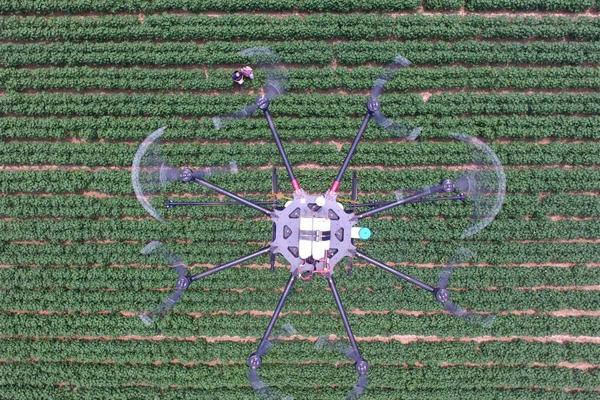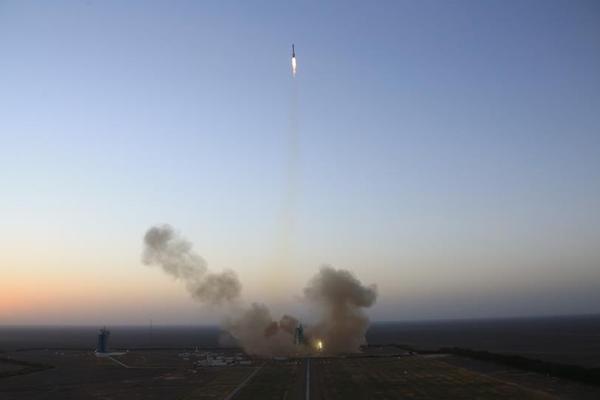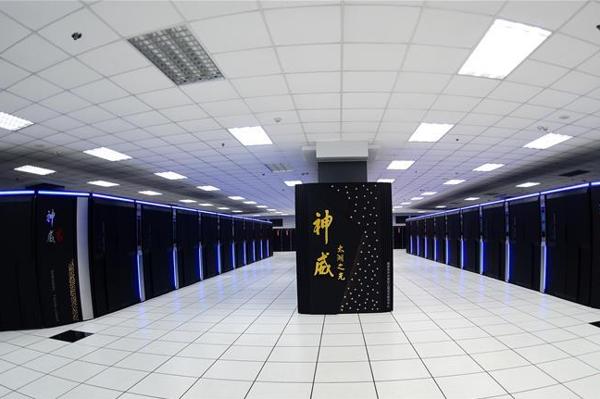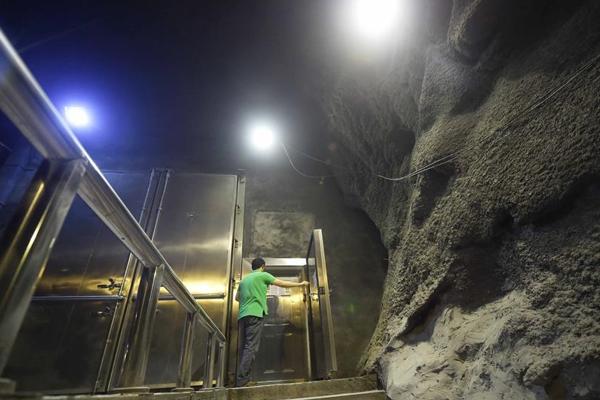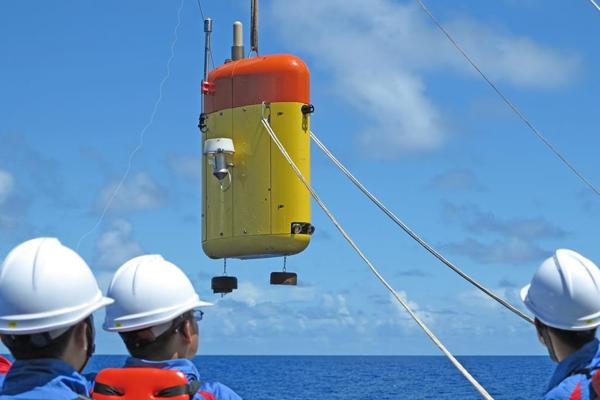Highlights of China’s scientific and technological achievements in 2016
2016-12-08
Xinhua
 A lithium-battery powered train suspended from a railway line runs in Chengdu, capital of southwest China’s Sichuan province, Nov 21, 2016. China’s first suspension railway line has conducted two-month test run. China achieved major breakthroughs in scientific and technological development in 2016. [Photo/Xinhua]
A lithium-battery powered train suspended from a railway line runs in Chengdu, capital of southwest China’s Sichuan province, Nov 21, 2016. China’s first suspension railway line has conducted two-month test run. China achieved major breakthroughs in scientific and technological development in 2016. [Photo/Xinhua]
 A J-20 stealth fighter of China flies at the 11th China International Aviation and Aerospace Exhibition in Zhuhai, south China’s Guangdong province, Nov 1, 2016. China’s domestic-built J-20 stealth fighter made its public debut during the exhibition. China achieved major breakthroughs in scientific and technological development in 2016. [Photo/Xinhua]
A J-20 stealth fighter of China flies at the 11th China International Aviation and Aerospace Exhibition in Zhuhai, south China’s Guangdong province, Nov 1, 2016. China’s domestic-built J-20 stealth fighter made its public debut during the exhibition. China achieved major breakthroughs in scientific and technological development in 2016. [Photo/Xinhua]
 Photo taken on Sept 24, 2016 shows the 500-meter Aperture Spherical Telescope (FAST) in Pingtang county, southwest China’s Guizhou province. The FAST, world’s largest radio telescope, measuring 500 meters in diameter, was completed and put into use on Sept 25. FAST, also called “China’s eye of heaven,” is the world’s largest and most sensitive radio telescope, and China holds the intellectual property rights to it. Work on the nearly 1.2-billion-yuan ($180 million) project started in 2011, and the installation of the telescope’s main structure -- a 4,450-panel reflector as large as 30 football pitches -- was finished in early July this year. FAST’s tasks include survey of neutral hydrogen in the space, observation of pulsars as well as spacecraft tracking and communications. China achieved major breakthroughs in scientific and technological development in 2016. [Photo/Xinhua]
Photo taken on Sept 24, 2016 shows the 500-meter Aperture Spherical Telescope (FAST) in Pingtang county, southwest China’s Guizhou province. The FAST, world’s largest radio telescope, measuring 500 meters in diameter, was completed and put into use on Sept 25. FAST, also called “China’s eye of heaven,” is the world’s largest and most sensitive radio telescope, and China holds the intellectual property rights to it. Work on the nearly 1.2-billion-yuan ($180 million) project started in 2011, and the installation of the telescope’s main structure -- a 4,450-panel reflector as large as 30 football pitches -- was finished in early July this year. FAST’s tasks include survey of neutral hydrogen in the space, observation of pulsars as well as spacecraft tracking and communications. China achieved major breakthroughs in scientific and technological development in 2016. [Photo/Xinhua]
 The screen at the Beijing Aerospace Control Center shows the two Chinese astronauts Jing Haipeng (L) and Chen Dong entering the space lab Tiangong-2, Oct 19, 2016. After the launch of Shenzhou-11 on Oct 17, the spacecraft docked two days later with China’s first space lab, Tiangong-2, where the two astronauts lived for 30 days. The two astronauts who completed China’s longest-ever manned space mission returned to Earth safely on Nov 18. China achieved major breakthroughs in scientific and technological development in 2016. [Photo/Xinhua]
The screen at the Beijing Aerospace Control Center shows the two Chinese astronauts Jing Haipeng (L) and Chen Dong entering the space lab Tiangong-2, Oct 19, 2016. After the launch of Shenzhou-11 on Oct 17, the spacecraft docked two days later with China’s first space lab, Tiangong-2, where the two astronauts lived for 30 days. The two astronauts who completed China’s longest-ever manned space mission returned to Earth safely on Nov 18. China achieved major breakthroughs in scientific and technological development in 2016. [Photo/Xinhua]
 An AG600, the China-made largest amphibious plane in the world, is displayed for the 11th China International Aviation and Aerospace Exhibition in Zhuhai, south China’s Guangdong province, Oct 30, 2016. The 37-meter-long AG600 with a wingspan of 38.8 meters, about the size of a Boeing 737, could be used to fight forest fires and perform marine rescue missions. China achieved major breakthroughs in scientific and technological development in 2016. [Photo/Xinhua]
An AG600, the China-made largest amphibious plane in the world, is displayed for the 11th China International Aviation and Aerospace Exhibition in Zhuhai, south China’s Guangdong province, Oct 30, 2016. The 37-meter-long AG600 with a wingspan of 38.8 meters, about the size of a Boeing 737, could be used to fight forest fires and perform marine rescue missions. China achieved major breakthroughs in scientific and technological development in 2016. [Photo/Xinhua]
 A high-speed train runs across farmland in Binyang county of Nanning, capital of south China’s Guangxi Zhuang autonomous region, Oct 16, 2016. China’s high-speed railways have exceeded 20,000 kilometers in length by September this year. China achieved major breakthroughs in scientific and technological development in 2016. [Photo/Xinhua]
A high-speed train runs across farmland in Binyang county of Nanning, capital of south China’s Guangxi Zhuang autonomous region, Oct 16, 2016. China’s high-speed railways have exceeded 20,000 kilometers in length by September this year. China achieved major breakthroughs in scientific and technological development in 2016. [Photo/Xinhua]
 A drone sprays pesticide over cotton fields in Zhaoshou village of Nangong city, north China’s Hebei province, July 6, 2016. Drone has been widely used in photography, fire extinguishing, agricultural control and other personal and commercial areas. China achieved major breakthroughs in scientific and technological development in 2016. [Photo/Xinhua]
A drone sprays pesticide over cotton fields in Zhaoshou village of Nangong city, north China’s Hebei province, July 6, 2016. Drone has been widely used in photography, fire extinguishing, agricultural control and other personal and commercial areas. China achieved major breakthroughs in scientific and technological development in 2016. [Photo/Xinhua]
 The Long March-2F carrier rocket carrying China’s Shenzhou-11 manned spacecraft blasts off from the launch pad at the Jiuquan Satellite Launch Center in Jiuquan, northwest China’s Gansu province, Oct 17, 2016. China achieved major breakthroughs in scientific and technological development in 2016. [Photo/Xinhua]
The Long March-2F carrier rocket carrying China’s Shenzhou-11 manned spacecraft blasts off from the launch pad at the Jiuquan Satellite Launch Center in Jiuquan, northwest China’s Gansu province, Oct 17, 2016. China achieved major breakthroughs in scientific and technological development in 2016. [Photo/Xinhua]
 Photo taken on June 20, 2016 shows Sunway-TaihuLight, a new Chinese supercomputer, in Wuxi, east China’s Jiangsu province. China’s new supercomputing system, Sunway-TaihuLight, was the world’s fastest computer at the International Supercomputing Conference in Germany on June 20, 2016. The massive supercomputer, built entirely using processors designed and made in China, dethroned the former champion, Tianhe-2, also a Chinese system but built based on Intel chips. TaihuLight is capable of performing 93 million billion calculations per second (petaflop/s). That’s almost three times as fast as Tianhe-2. China achieved major breakthroughs in scientific and technological development in 2016. [Photo/Xinhua]
Photo taken on June 20, 2016 shows Sunway-TaihuLight, a new Chinese supercomputer, in Wuxi, east China’s Jiangsu province. China’s new supercomputing system, Sunway-TaihuLight, was the world’s fastest computer at the International Supercomputing Conference in Germany on June 20, 2016. The massive supercomputer, built entirely using processors designed and made in China, dethroned the former champion, Tianhe-2, also a Chinese system but built based on Intel chips. TaihuLight is capable of performing 93 million billion calculations per second (petaflop/s). That’s almost three times as fast as Tianhe-2. China achieved major breakthroughs in scientific and technological development in 2016. [Photo/Xinhua]
 An experimenter of Dark Matter Experiment “PandaX”, which means Particle and Astrophysical Xenon Detector, enters the Jinping Underground Laboratory, located at 2,400 meters under the surface of Jinping Hydropower Station, in southwest China’s Sichuan province, June 28, 2016. PandaX is designed to build and operate a ton-scale liquid xenon experiment to detect the dark matter, invisible material that scientists say makes up most of the universe’s mass. The PandaX program, headed by China’s Shanghai Jiao Tong University, was conducted in the Jinping lab, one of the world’s deepest underground labs opened in December 2010. The Jinping lab provides a “clean” space for scientists to pursue the dark matter. Researchers said the extreme depth helps block most cosmic rays that mess with the observation. China achieved major breakthroughs in scientific and technological development in 2016. [Photo/Xinhua]
An experimenter of Dark Matter Experiment “PandaX”, which means Particle and Astrophysical Xenon Detector, enters the Jinping Underground Laboratory, located at 2,400 meters under the surface of Jinping Hydropower Station, in southwest China’s Sichuan province, June 28, 2016. PandaX is designed to build and operate a ton-scale liquid xenon experiment to detect the dark matter, invisible material that scientists say makes up most of the universe’s mass. The PandaX program, headed by China’s Shanghai Jiao Tong University, was conducted in the Jinping lab, one of the world’s deepest underground labs opened in December 2010. The Jinping lab provides a “clean” space for scientists to pursue the dark matter. Researchers said the extreme depth helps block most cosmic rays that mess with the observation. China achieved major breakthroughs in scientific and technological development in 2016. [Photo/Xinhua]
 An automatic driverless super truck manufactured by Beijing-based automaker Foton Motor is shown on an intelligent connected vehicle expo in Shanghai, east China, Nov 14, 2016. China achieved major breakthroughs in scientific and technological development in 2016. [Photo/Xinhua]
An automatic driverless super truck manufactured by Beijing-based automaker Foton Motor is shown on an intelligent connected vehicle expo in Shanghai, east China, Nov 14, 2016. China achieved major breakthroughs in scientific and technological development in 2016. [Photo/Xinhua]
 China’s unmanned submersible “Haidou-1” prepares to dive into waters near the Mariana Trench in the West Pacific, the deepest area in the world, during a scientific expedition on July 1, 2016. During the trip, the submersible dived to a depth of 10,767 meters, setting a new record for the country. It is another milestone in China’s maritime science journey after Jiaolong manned submersible. In June 2012, Jiaolong reached a depth of 7,062 meters at the Mariana Trench, the deepest of China’s manned submersible. China achieved major breakthroughs in scientific and technological development in 2016. [Photo/Xinhua]
China’s unmanned submersible “Haidou-1” prepares to dive into waters near the Mariana Trench in the West Pacific, the deepest area in the world, during a scientific expedition on July 1, 2016. During the trip, the submersible dived to a depth of 10,767 meters, setting a new record for the country. It is another milestone in China’s maritime science journey after Jiaolong manned submersible. In June 2012, Jiaolong reached a depth of 7,062 meters at the Mariana Trench, the deepest of China’s manned submersible. China achieved major breakthroughs in scientific and technological development in 2016. [Photo/Xinhua]
A lithium-battery powered train suspended from a railway line runs in Chengdu, capital of southwest China’s Sichuan province, Nov 21, 2016. China’s first suspension railway line has conducted two-month test run. China achieved major breakthroughs in scientific and technological development in 2016. [Photo/Xinhua]
A J-20 stealth fighter of China flies at the 11th China International Aviation and Aerospace Exhibition in Zhuhai, south China’s Guangdong province, Nov 1, 2016. China’s domestic-built J-20 stealth fighter made its public debut during the exhibition. China achieved major breakthroughs in scientific and technological development in 2016. [Photo/Xinhua]
Photo taken on Sept 24, 2016 shows the 500-meter Aperture Spherical Telescope (FAST) in Pingtang county, southwest China’s Guizhou province. The FAST, world’s largest radio telescope, measuring 500 meters in diameter, was completed and put into use on Sept 25. FAST, also called “China’s eye of heaven,” is the world’s largest and most sensitive radio telescope, and China holds the intellectual property rights to it. Work on the nearly 1.2-billion-yuan ($180 million) project started in 2011, and the installation of the telescope’s main structure -- a 4,450-panel reflector as large as 30 football pitches -- was finished in early July this year. FAST’s tasks include survey of neutral hydrogen in the space, observation of pulsars as well as spacecraft tracking and communications. China achieved major breakthroughs in scientific and technological development in 2016. [Photo/Xinhua]
The screen at the Beijing Aerospace Control Center shows the two Chinese astronauts Jing Haipeng (L) and Chen Dong entering the space lab Tiangong-2, Oct 19, 2016. After the launch of Shenzhou-11 on Oct 17, the spacecraft docked two days later with China’s first space lab, Tiangong-2, where the two astronauts lived for 30 days. The two astronauts who completed China’s longest-ever manned space mission returned to Earth safely on Nov 18. China achieved major breakthroughs in scientific and technological development in 2016. [Photo/Xinhua]
An AG600, the China-made largest amphibious plane in the world, is displayed for the 11th China International Aviation and Aerospace Exhibition in Zhuhai, south China’s Guangdong province, Oct 30, 2016. The 37-meter-long AG600 with a wingspan of 38.8 meters, about the size of a Boeing 737, could be used to fight forest fires and perform marine rescue missions. China achieved major breakthroughs in scientific and technological development in 2016. [Photo/Xinhua]
A high-speed train runs across farmland in Binyang county of Nanning, capital of south China’s Guangxi Zhuang autonomous region, Oct 16, 2016. China’s high-speed railways have exceeded 20,000 kilometers in length by September this year. China achieved major breakthroughs in scientific and technological development in 2016. [Photo/Xinhua]
A drone sprays pesticide over cotton fields in Zhaoshou village of Nangong city, north China’s Hebei province, July 6, 2016. Drone has been widely used in photography, fire extinguishing, agricultural control and other personal and commercial areas. China achieved major breakthroughs in scientific and technological development in 2016. [Photo/Xinhua]
The Long March-2F carrier rocket carrying China’s Shenzhou-11 manned spacecraft blasts off from the launch pad at the Jiuquan Satellite Launch Center in Jiuquan, northwest China’s Gansu province, Oct 17, 2016. China achieved major breakthroughs in scientific and technological development in 2016. [Photo/Xinhua]
Photo taken on June 20, 2016 shows Sunway-TaihuLight, a new Chinese supercomputer, in Wuxi, east China’s Jiangsu province. China’s new supercomputing system, Sunway-TaihuLight, was the world’s fastest computer at the International Supercomputing Conference in Germany on June 20, 2016. The massive supercomputer, built entirely using processors designed and made in China, dethroned the former champion, Tianhe-2, also a Chinese system but built based on Intel chips. TaihuLight is capable of performing 93 million billion calculations per second (petaflop/s). That’s almost three times as fast as Tianhe-2. China achieved major breakthroughs in scientific and technological development in 2016. [Photo/Xinhua]
An experimenter of Dark Matter Experiment “PandaX”, which means Particle and Astrophysical Xenon Detector, enters the Jinping Underground Laboratory, located at 2,400 meters under the surface of Jinping Hydropower Station, in southwest China’s Sichuan province, June 28, 2016. PandaX is designed to build and operate a ton-scale liquid xenon experiment to detect the dark matter, invisible material that scientists say makes up most of the universe’s mass. The PandaX program, headed by China’s Shanghai Jiao Tong University, was conducted in the Jinping lab, one of the world’s deepest underground labs opened in December 2010. The Jinping lab provides a “clean” space for scientists to pursue the dark matter. Researchers said the extreme depth helps block most cosmic rays that mess with the observation. China achieved major breakthroughs in scientific and technological development in 2016. [Photo/Xinhua]
An automatic driverless super truck manufactured by Beijing-based automaker Foton Motor is shown on an intelligent connected vehicle expo in Shanghai, east China, Nov 14, 2016. China achieved major breakthroughs in scientific and technological development in 2016. [Photo/Xinhua]
China’s unmanned submersible “Haidou-1” prepares to dive into waters near the Mariana Trench in the West Pacific, the deepest area in the world, during a scientific expedition on July 1, 2016. During the trip, the submersible dived to a depth of 10,767 meters, setting a new record for the country. It is another milestone in China’s maritime science journey after Jiaolong manned submersible. In June 2012, Jiaolong reached a depth of 7,062 meters at the Mariana Trench, the deepest of China’s manned submersible. China achieved major breakthroughs in scientific and technological development in 2016. [Photo/Xinhua]






